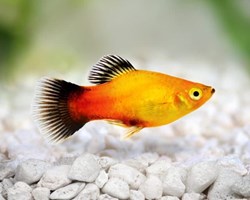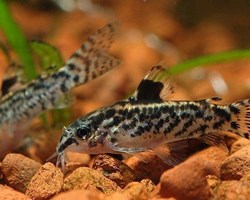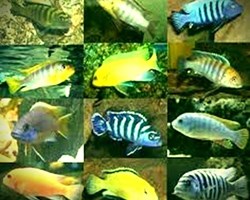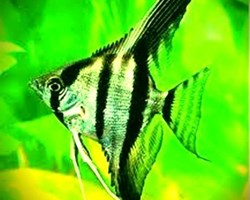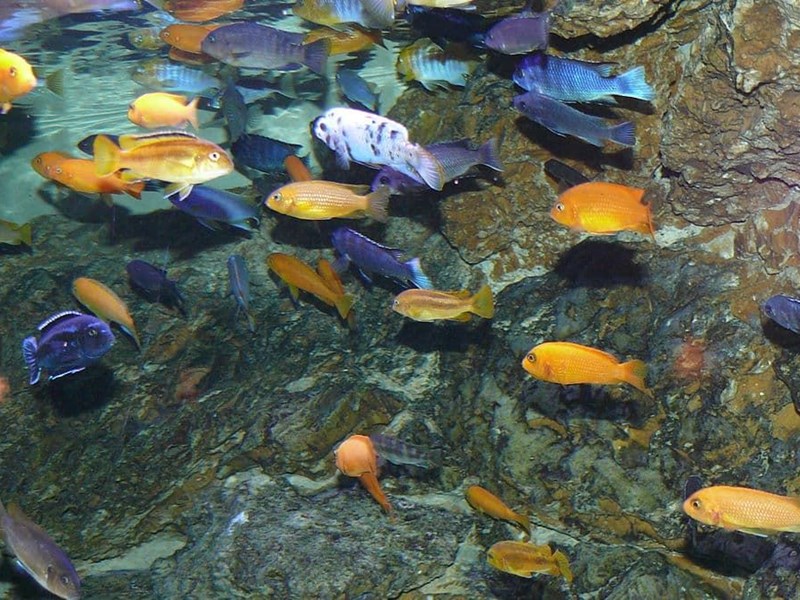
THE CICHLIDS OF LAKE MALAWI:
The so-called Rift Valley in Africa has a certain number of lakes that have achieved importance among aquarists as sources of supply for fish of the Cichlidae family.
Two of these, Lake Malawi and Lake Tanganyika, provide most of the imported species, the former having more than 250 well-described species and certainly many more to come.
Like Lake Tanganyika, Lake Malawi has an unusual chemical composition regarding its water: the pH is strongly alkaline, generally between 7.7 and 8.6, and the water is extremely hard.
In Malawi the cichlid fauna is conveniently divided into the Haplochromid species and the numas or rock-dwelling cichlids.
Somewhere between the two groups are such genera as the peacocks, aulonocara, and Trematocramus .
Although most closely related to the Haplochromis species, they are found among the rocks and have been given the honorary status of mbuna by aquarists.
Most of the components of the Haplochromis species are fish with great swimming capacity that have an elongated body in the case of males and that adopt a blue coloration when the spawning season arrives.
Haplochromis moorii is perhaps the most desirable species and a real challenge for aquarists.
Malawi boasts over 100 species of Haplochromis, with many more awaiting discovery and description.
Such fish dazzle the aquarist with shades of blue along with violet and green.
Several species of mbuna have developed brilliant color combinations, and of these, perhaps the best known is the earliest imported zebra, Pseudotropheus tropheops , and the two species of Labeotropheus .
New varieties and species of mbuna are constantly imported but few have surpassed these original species among the hobby.
Lake Malawi cichlids are mostly easy to keep, hardy and good layers.
AQUARIUM WATER CONDITIONS:
They need a water with a very alkaline pH, a lot of space and a large number of cavities in the rock, especially for the mbuna .
NUTRITION OF LAKE MALAWI CICHLIDS:
They should receive some plant in their diet, as they feed especially on algae in nature, but they will eat almost any type of prepared aquarium food.
REPRODUCTION OF LAKE MALAWI CICHLIDS:
Most Lake Malawi cichlids are mouthbrooders.
The female takes the fertilized eggs into her mouth and incubates them in her oral cavity, not only until the fry hatch, but until they are developed enough to swim.
LAKE MALAWI CICHLIDS ARE:
- HAPLOCHROMIS SP.: pH 8.2, H15, 28ºC, 20 cm and 150 L of the aquarium.
- HAPLOCROMIS "ELECTRIC BLUE": pH 8.2, H16, 28ºC, 13 cm, and 100 L of the aquarium.
- HAPLOCHROMIS FENESTRATUS: pH 8.0, H 15, 28ºC, 13 cm and 100 L of the aquarium.
- HAPLOCHROMIS CF. FENESTRATUS: pH 8.1, H 22, 28ºC, 10 cm, 100 L of the aquarium.
- HAPLOCHROMIS SPILONOTUS: pH 8.0, H 20, 27ºC, 10 cm, 100 L of the aquarium.
- IAPLOCHROMIS VIRGINALIS: pH 8.0, H 20, 28ºC, 10 com, 80 L of the aquarium.
- HAPLOCHROMIS SIMILIS: pH 8.2, H 20, 28ºC, 12 cm, 100 L of the aquarium.
- HAPLOCHROMIS CF. FENESTRATUS: pH 8.1, H 22, 28ºC, 10 cm, and 100 L of the aquarium.
- HAPLOCHROMIS STRIGATUS: pH 8.2, H 20, 28ºC, 20 cm, and 200 L of the aquarium.
- HAPLOCHROMIS COMPRESSICEPS: pH 8.0, H 22, 28ºC, 26 cm and 300 L of the aquarium.
- HAPLOCHROMIS CF. LABRIDENS: pH 8.1, H 20, 27ºC, 12 cm and 100 L of the aquarium.
- HAPLOCHROMIS CF. TAENIOLATUS : pH 8.0, H 20, 28ºC, 11 cm and 100 L of the aquarium.
- HAPLOCHROMIS MOORII: pH 8.1, H 22, 28ºC, 23 cm and 300 L of the aquarium.
- HAPLOCHROMIS ELECTRA: pH 8.1, H 21, 27ºC, 15 cm and 200 L of the aquarium.
- HAPLOCHROMIS CALLIPTERUS: pH 8.0, H 20, 27ºC, 10 cm and 100 L of the aquarium.
- HAPLOCHROMIS VENUSTRUS: pH 8.1, H 22, 28ºC, 22 cm and 300 L of the aquarium.
- HAPLOCHROMIS MLOTO: pH 8.1, H 20, 27ºC, 10 cm and 100 L of the aquarium.
- HAPLOCHROMIS CF. EUCHILUS: pH 8.2, H 20, 27ºC, 33 cm and 400 L of the aquarium.
- HAPLOCHROMIS VENUSTUS: pH 8.1, H 22, 28ºC, 22 cm and 300 L of the aquarium.
- HAPLOCHROMIS EUCHILUS: pH 8.2, H 20, 27ºC, 33 cm and 400 L of the aquarium.
- HAPLOCHROMIS FUSCOTAENIATUS: pH 8.0, H 22, 28ºC, 25 cm and 300 L of the aquarium.
- HAPLOCHROMIS POLYSTIGMA: pH 8.0, H 22, 27ºC, 26 cm and 300 L of the aquarium.
- HAPLOCHROMIS LINNI: pH 8.1, H 21, 27ºC, 35 cm and 400 L of the aquarium.
- HAPLOCHROMIS LIVINGSTONI: pH 8.0, H 22, 27ºC, 30 cm and 400 L of the aquarium.
- HAPLOCHROMIS FUSCOTAENIATUS: pH 8.0, H 22, 28ºC, 25 cm and 300 L of the aquarium.
- HAPLOCHROMIS OXYRHYNCHUS: pH 8.2, H 22, 27ºC, 20 cm and 200 L of the aquarium.
- PATROTYLAPIA NIGRA: pH 8.2, H 20, 26ºC, 25 cm and 150 L of the aquarium.
- GENYOCHROMIS MENTO: pH 8.2, H 22, 28ºC, 12 cm and 100 L of the aquarium.
- CHILOTILAPIA RHODESLI: pH 8.2, H 22, 28ºC, 22 cm and 300 L of the aquarium.
- CLEITHROCHROMIS BOWLEYI: pH 8.0, H 21, 27ºC, 16 cm and 150 L of the aquarium.
- PETROTILAPIA TRIDENTIGER: pH 8.1, H 22, 27ºC, 12 cm and 100 L of the aquarium.
- TREMATOCRANUS PETERDAVIESI: pH 8.2, H21, 27ºC, 15 cm and 200 L of the aquarium.
- LETHRINOPS CHRISTYI: pH 8.0, H20, 27ºC, 16 cm and 200 L of the aquarium.
- LETHRINOPS FURCICAUDA: pH 8.2, H 20, 28ºC, 14 cm and 200 L of the aquarium.
- TREMATOCRANUS SP.: pH 8.0, H 21, 27ºC, 18 cm and 300 L of the aquarium.
- LETHRINOPS AURITA: pH 8.2, H 21, 27ºC, 12 cm and 100 L of the aquarium.
- LETHRINOPS FURCICAUDA: pH 8.2, H 20, 28ºC, 14 cm and 200 L of the aquarium.
- AULONOCARA NYASSAE: pH 8.1, H 20, 27ºC, 16 cm and 200 L of the aquarium.
- AULONOCARA SP. (AULONOCORA NOCTURNA): pH 8.1, H 21, 27ºC, 14 cm and 200 L of the aquarium.
- AULONOCARA SP. (WHITE DORSAL EDGE): pH 8.1, H 20, 27ºC, 15 cm and 200 L of the aquarium.
- MELANOCHROMIS JOHANNI: pH 8.0, H 21, 27ºC, 12 cm and 100 L of the aquarium.
- MELANOCHROMIS MELANOPTERUS: pH 8.1, H 22, 27ºC, 15 cm and 200 L of the aquarium.
- MELANOCHROMIS PERSPICAX: pH 8.1, H 22, 27ºC, 13 cm and 100 L of the aquarium.
- MELANOCHROMIS PARALLELUS: pH 8.2, H 22, 28ºC, 15 cm and 100 L of the aquarium.
- MELANOCHROMIS AURATUS: pH 8.1, H 22, 27ºC, 20 cm and 200 L of the aquarium.
- MELANOCHROMIS CHIPOKEE: pH 8.1, H 22, 27ºC, 12 cm and 100 L of the aquarium.
- MELANOCHROMIS AIMULANS: pH 8.2, H 22, 27ºC, 12 cm and 100 L of the aquarium.
- MELANOCHROMIS VERMOVORUS: pH 8.1, H 22, 27ºC, 11 cm and 100 L of the aquarium.
- LABIDOCHROMIS SP. : pH 8.0, H 21, 27ºC, 8 cm and 100 L of the aquarium.
- LABIDOCHROMIS TEXTILIS: pH 8.2, H 15, 28 ºC, 15 cm and 100 L of the aquarium.
- LABIDOCHROMIS EXASPERATUS: pH 8.2, H 15 cm and 100 L of the aquarium.
- LABIDOCHROMIS JOANJOHNSONAE: pH 8.2, H 15, 28ºC, 12 cm and 100 L of the aquarium.
- PSEUDOTROPHEUS NOVEMFASCIATUS: pH 8.0, H 22, 27ºC, 10 cm and 100 L of the aquarium.
- IODOTROPHEUS SPRENGERAE: pH 8.0, H 22, 27ºC, 8 CM, and 100 L of the aquarium.
- GEPHYROCHROMIS MOORII: pH 8.0, H 21, 27ºC, 10 cm and 100 L of the aquarium.
- PSEUDOTROPHEUS TROPHEOPS: pH 8.2, H 20, 28ºC, 10 cm and 100 L of the aquarium.
- PSEUDPTRPHEUS SP.: pH 8.1, H 20, 28ºC, 10 cm and 100 L of the aquarium.
- GEPHYROCHROMIS LAWSI: pH 8.1, H 20, 27ºC, 10 cm and 100 L of the aquarium.
- PSEUDOTROPHEUS TROPHEOPS: pH 8.2, H 15, 26ºC, 20 cm and 100 L of aquarium.
- PSEUDOTROPHEUS ELONGATUS: pH 8.0, H 22, 27ºC, 10 cm and 100 L of the aquarium.
- PSEUDOTROPHEUS SP.: pH 8.0, H 20, 28ºC, 8 cm and 100 L of the aquarium.
- PSEUDOTROPHEUS BREVIS: pH 8.0, H 22, 27ºC, 10 cm and 100 L of the aquarium.
- PSEUDOTROPHEUS IANISTICOLA: pH 8.1, H 20, 28ºC, 9 cm and 100 L of the aquarium.
- PSEUDOTROPHEUS "EDUARDI": pH 8.2, H 21, 28ºC, 8 cm and 100 L of the aquarium.
- PSEUSOTROPHEUS ZEBRA: pH 8.1, H 22, 27ºC, 12 cm and 100 L of the aquarium.
- PSEUDOTROPHEUS WILLIAMSI: pH 8.1, H 22, 28ºC, 15 cm and 200 L of the aquarium.
- PSEUDOTROPHEUS LOMBARDOI: pH 8.1, H 22, 27ºC, 13 cm and 100 L of the aquarium.
- CYNOTILAPIA SP. : pH 8.1, H 22, 28ºC, 8 cm and 100 L of the aquarium.
- CYNOTILAPIA AFRA: pH 8.0, H 21, 28ºC, 8 cm and 100 L of the aquarium.
- CYNOTILAPIA ACELRODI: pH 8.1, H 22, 27ºC, 8 cm and 100 L of the aquarium.
- LABEOTROPHEUS FUELLEBORNI: pH 8.0, H 22, 28ºC, 13 cm and 100 L of the aquarium.
- LABEOTROPHEUS TREWAVASAE: pH 8.1, H 21, 27ºC, 10 cm and 100 L of the aquarium.
Dr. Axelrod: Mini Atlas of Freshwater Aquarium Fishes. 1992, European Hispanic, p. 112.
At Glu Glu Pet we do not have these fish in store because they are very aggressive fish and have to be alone, they are very showy, but this characteristic must be taken into account, therefore, they must be ordered to be supplied.
Related Glu Glu pet products:
- 100L aqualed aquarium kit with Optimus filter (ICA).
- TETRA CICHLIDS.
- Royal cichlid PELLET PREMIUM 330ml. (AZOO).
- EHEIM CLASSIC 150 / 2211.
- Fluval 207 External Filter.
- Anubia Barteri var. potted lullaby
Related Posts:

